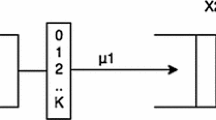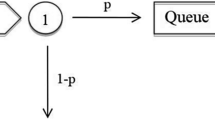Abstract
We study the departure times in tandem production lines where the products passing through the lines are either discrete entities or continuous fluid. We call these discrete tandem (DT) or continuous tandem (CT) lines, respectively. We apply sample path analysis techniques to relate the departure time in a DT line to the departure time in a CT line where both lines have equivalent model parameters. We show that the departure time of a quantity q, produced at a machine in a DT line governed by the communication blocking mechanism, converges to the departure time of the same quantity at the same machine in the corresponding CT line as the size of the products in the DT line becomes infinitesimally small. Since continuous fluid models are used in both queueing and control systems to approximate the behavior of discrete systems, this asymptotic result enhances the understanding and the use of such models. Finally, our result also leads to an alternative proof for the convexity of the departure time in CT lines.
Similar content being viewed by others
References
Altiok, T., and Stidham Jr., S. 1982. A note on transfer lines with unreliable machines, random processing times, and finite buffers. IIE Trans. 14(2): 125–127.
Alvarez, R., Dallery, Y., and David, R. 1991. An experimental study of the continuous flow model of transfer lines with unreliable machines and finite buffers. IMACS-IFAC Symposium. Modeling and Control of Technological Systems, Lille, France.
Buzacott, J. A., and Hanifin, L. E. 1978. Models of automatic transfer lines with inventory banks: A review and comparison. AIIE Trans. 10(2): 197–207.
Chen, D. W., and Yao, D. D. 1993. Tandem queues with general blocking: A unified model and comparison results. J. Discrete Event Dynamic Systems: Theory and Applications 2: 207–234.
D'Angelo, H., Caramanis, M., Finger, S., Mavretic, A., Phillis, Y. A., and Ramsden, E. 1988. Event-driven model of unreliable production lines with storage. Int. J. Prod. Res. 26(7): 1173–1182.
De Koster, R., and Wijngaard, J. 1989. Continuous vs. discrete models for production lines with blockings. Queueing Networks with Blockings. H. G. Perros and T. Altiok, editors. North-Holland.
Gershwin, S. B., and Berman, O. 1981. Analysis of transfer lines consisting of two unreliable machines with random processing times and finite storage buffers. AIIE Trans 13(1): 2–11.
Glasserman, P., and Yao, D. D. 1991. Algebraic structure of some stochastic discrete event systems with applications. J. Discrete Event Dynamic Systems: Theory and Applications 1: 7–35.
Hu, J.-Q. 1992. Convexity of sample path performance and strong consistency of infinitesimal perturbation analysis. IEEE Trans. on Auto. Control 37(2): 258–262.
Robinson, S. M. 1995. Convergence of subdifferentials under strong stochastic convexity. Management Science 41(8): 1397–1401.
Shanthikumar, J. G., and Yao, D. D. 1989. Second-order stochastic properties in queueing systems. Proceedings of the IEEE 77(1): 162–170.
Shanthikumar, J. G., and Yao, D. D. 1991. Strong stochastic convexity: closure properties and applications. Journal of Applied Probability 28(1): 131–145.
Shi, L., B.-R. Fu, and Suri, R. 1999. Sample path analysis for continuous tandem production lines. J. Discrete Event Dynamic Systems: Theory and Applications 9: 211–239.
Suri, R., and Fu, B.-R. 1994. On using continuous lines to model discrete production lines. J. Discrete Event Dynamic Systems: Theory and Applications 4: 129–169.
Author information
Authors and Affiliations
Rights and permissions
About this article
Cite this article
Fu, BR., Shi, L. & Suri, R. Analysis of Departure Times in Discrete and Continuous Tandem Production Lines. Discrete Event Dynamic Systems 12, 159–186 (2002). https://doi.org/10.1023/A:1014574920289
Issue Date:
DOI: https://doi.org/10.1023/A:1014574920289




